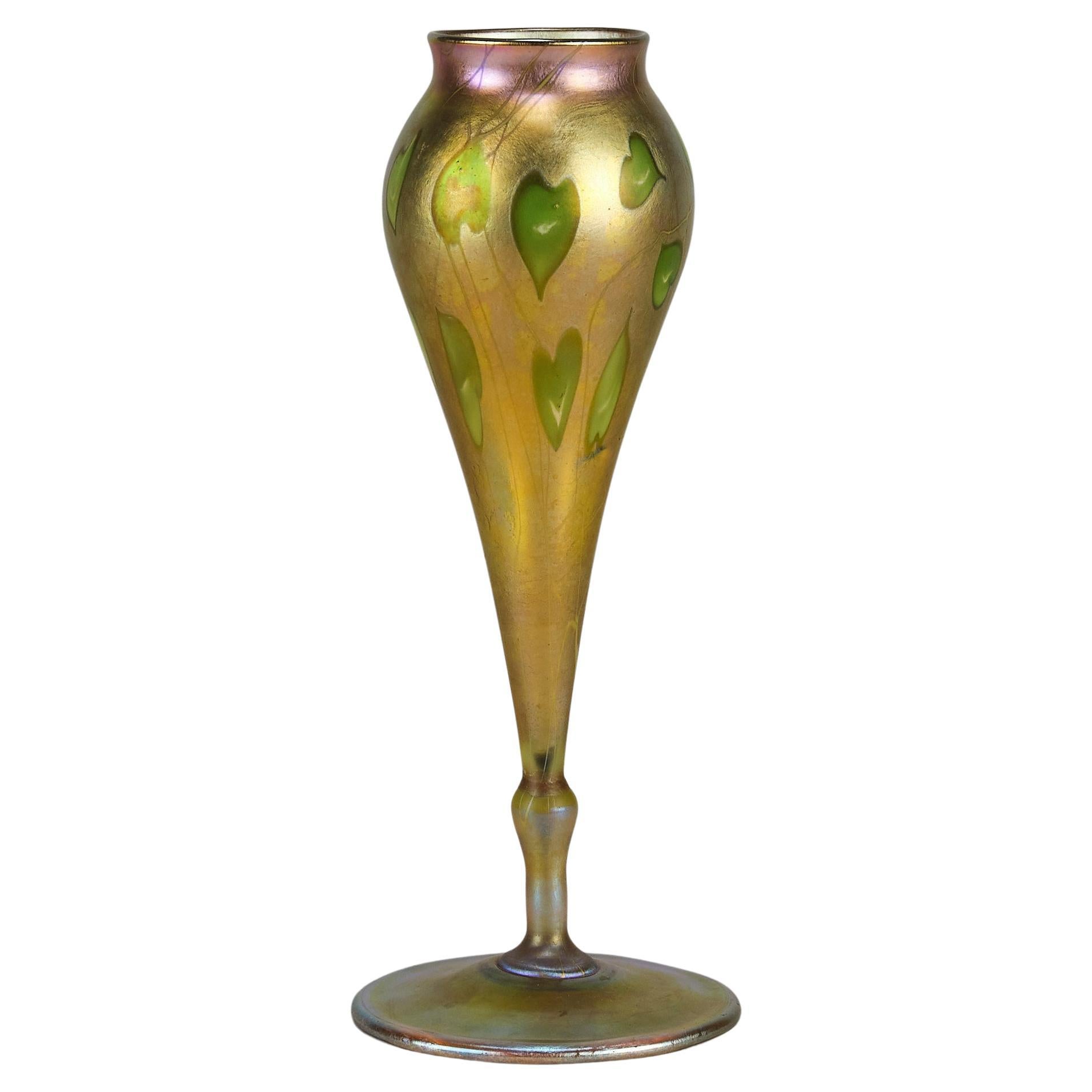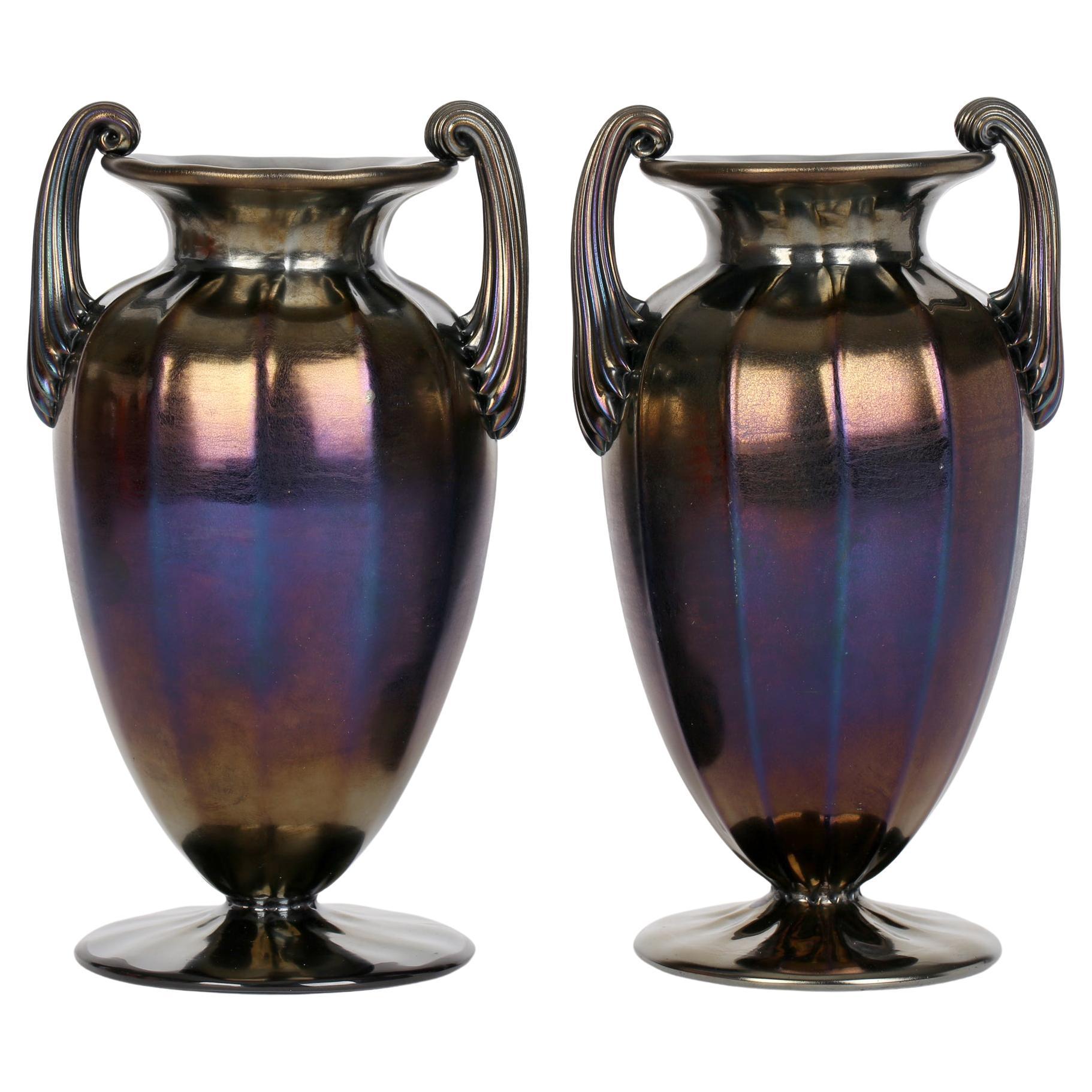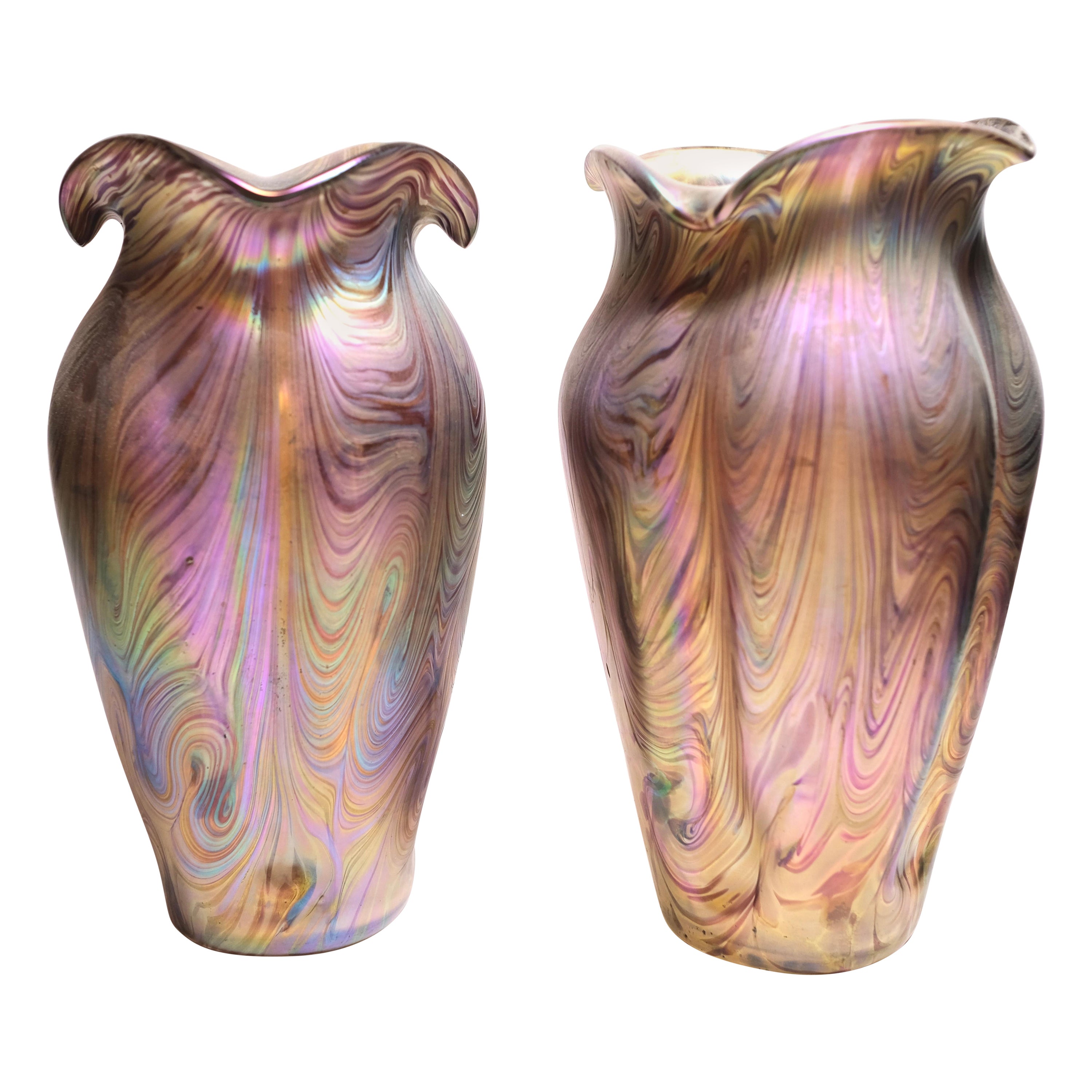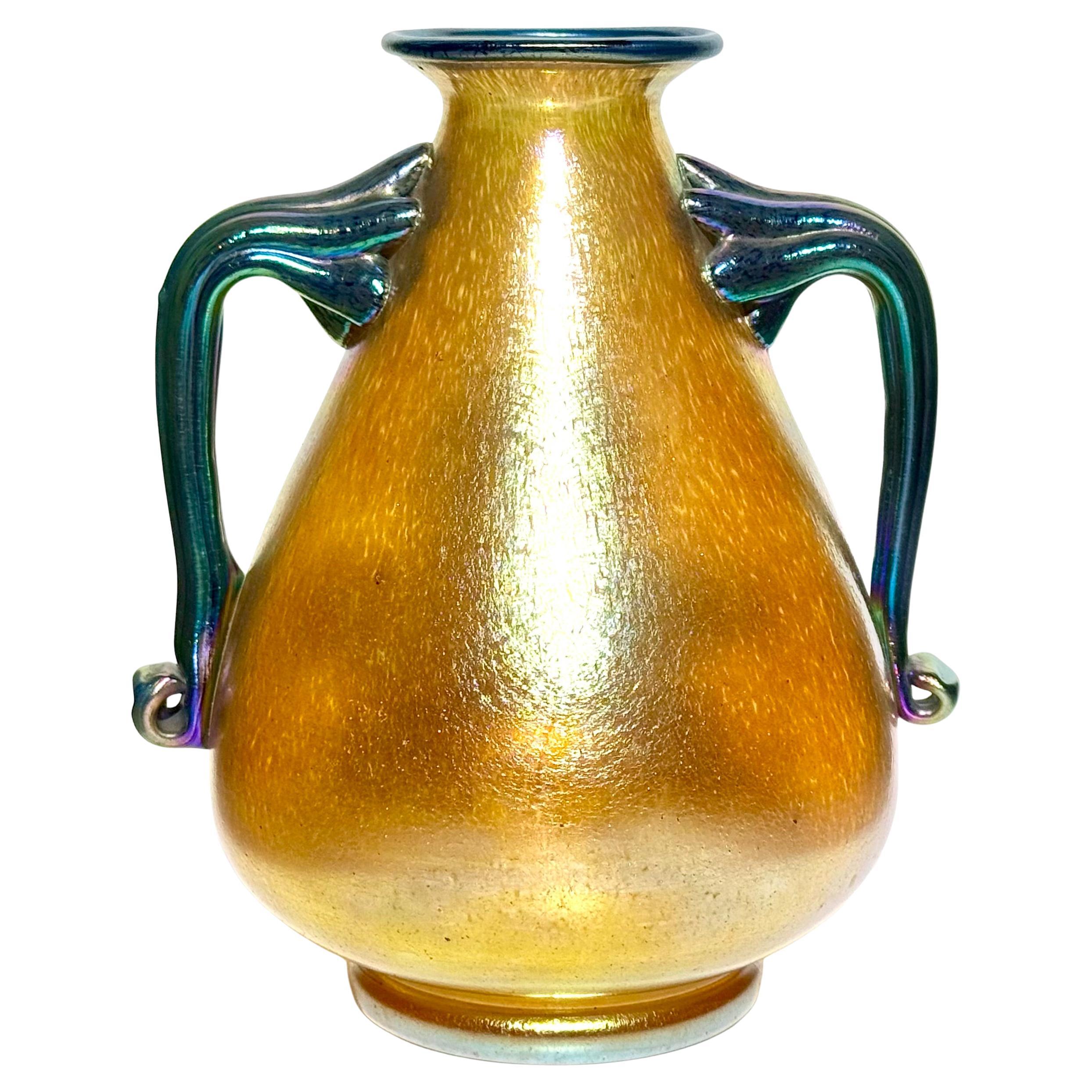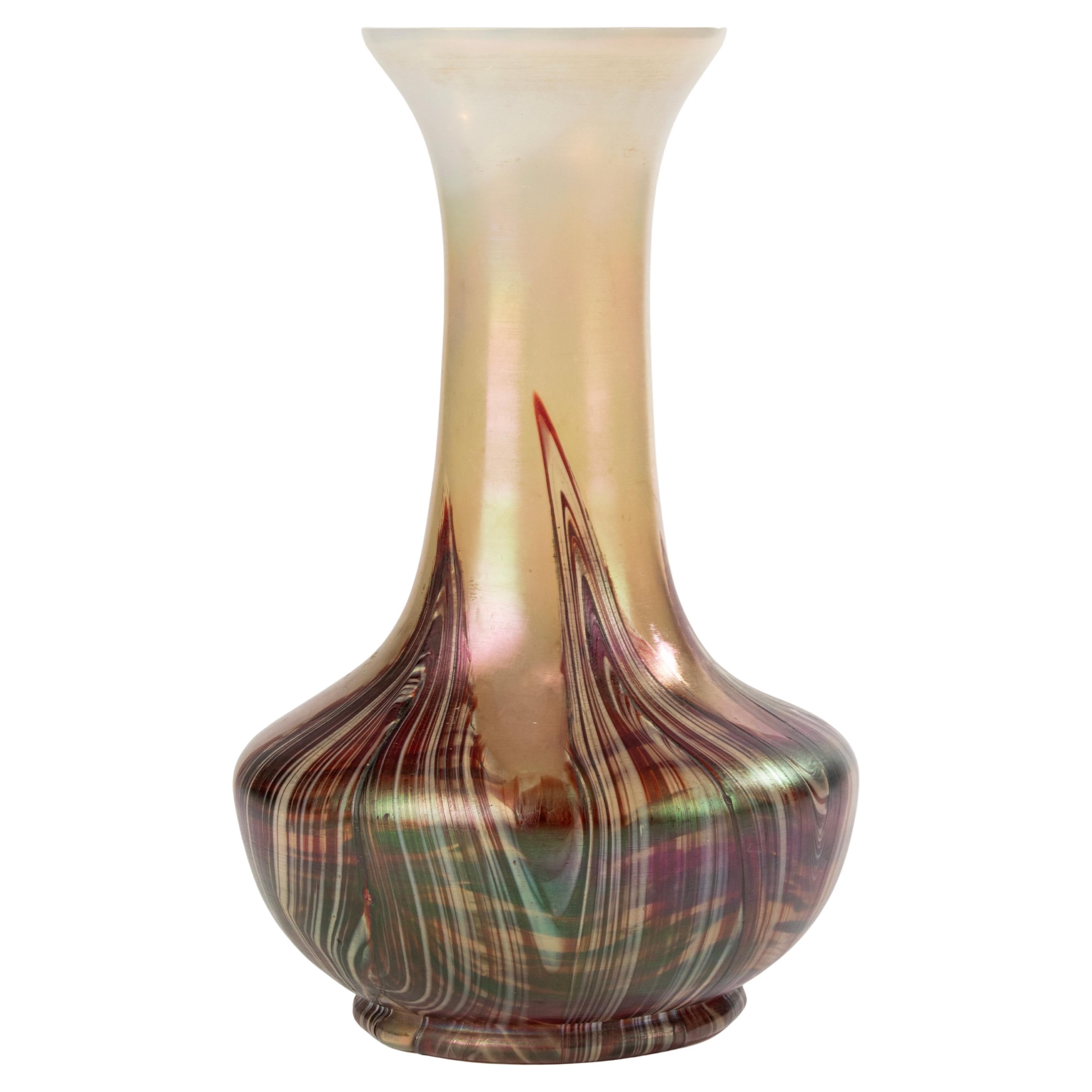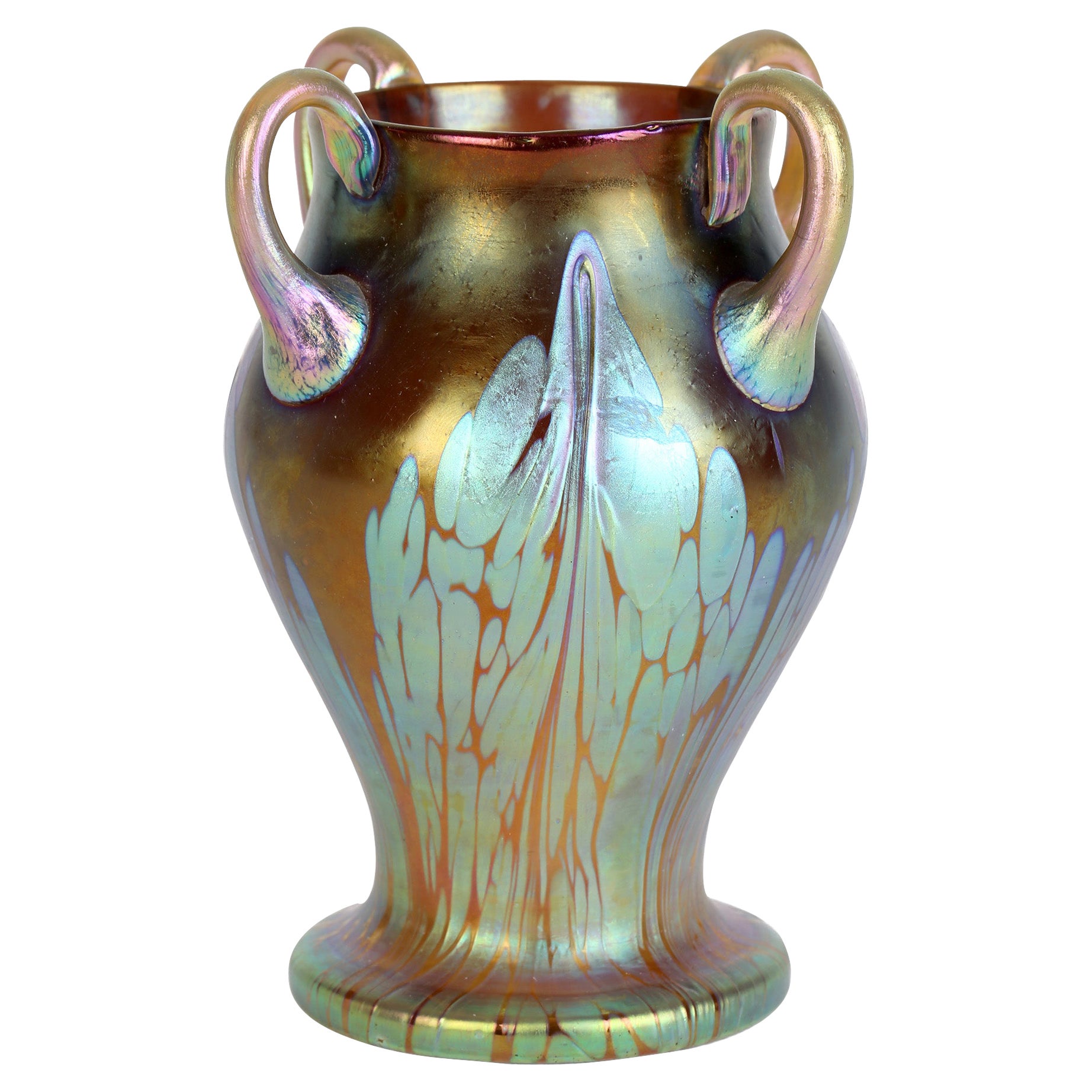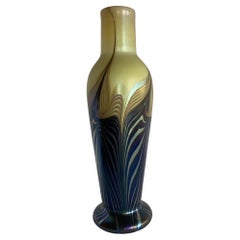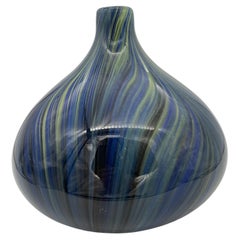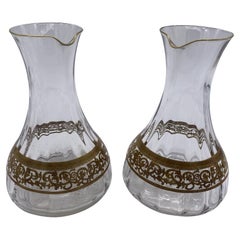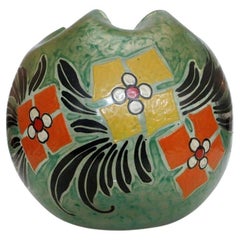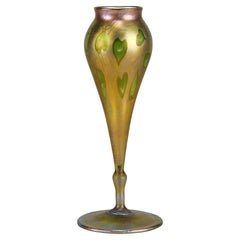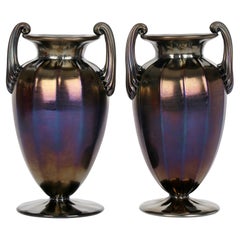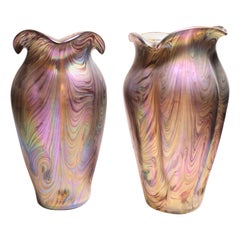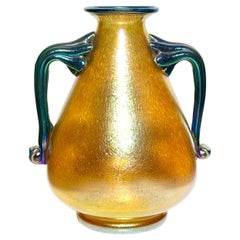Items Similar to Rare Early 20th Iridescent Handblown Heart & Vine Vase Set by Imperial
Want more images or videos?
Request additional images or videos from the seller
1 of 16
Rare Early 20th Iridescent Handblown Heart & Vine Vase Set by Imperial
$4,920per set
$8,200per set40% Off
£3,712.99per set
£6,188.31per set40% Off
€4,250.81per set
€7,084.68per set40% Off
CA$6,938.83per set
CA$11,564.72per set40% Off
A$7,617.97per set
A$12,696.62per set40% Off
CHF 3,974.31per set
CHF 6,623.85per set40% Off
MX$92,188.06per set
MX$153,646.76per set40% Off
NOK 49,811.83per set
NOK 83,019.72per set40% Off
SEK 46,935.84per set
SEK 78,226.40per set40% Off
DKK 31,731.17per set
DKK 52,885.28per set40% Off
About the Item
The original "Heart & Vine" Vase Set by Imperial showcases the exquisite craftsmanship of Imperial Glass, featuring an iridescent finish that beautifully captures hues of green and red. The vase’s Art Nouveau styling is elegant and flowing, reflecting the organic forms characteristic of the movement. Its almost rose gold-like sheen shifts from yellow, reddish, and gold tones that change hue depending on how the light hits the surface.
Both vases come with the original gold-tone foil Imperial label along the bottom.
-Measurements-
Small- 8" Tall X 6" Diameter
Large- 11" Tall X 4" Diameter
United States, 1910
- Creator:Imperial Glass Company (Maker)
- Dimensions:Height: 11 in (27.94 cm)Diameter: 4 in (10.16 cm)
- Sold As:Set of 2
- Materials and Techniques:
- Place of Origin:
- Period:1910-1919
- Date of Manufacture:1910
- Condition:excellent.
- Seller Location:Van Nuys, CA
- Reference Number:Seller: 2051402.JM.4MS1stDibs: LU947442118872
About the Seller
4.7
Platinum Seller
Premium sellers with a 4.7+ rating and 24-hour response times
Established in 1969
1stDibs seller since 2012
1,379 sales on 1stDibs
Typical response time: 1 hour
- ShippingRetrieving quote...Shipping from: Van Nuys, CA
- Return Policy
Authenticity Guarantee
In the unlikely event there’s an issue with an item’s authenticity, contact us within 1 year for a full refund. DetailsMoney-Back Guarantee
If your item is not as described, is damaged in transit, or does not arrive, contact us within 7 days for a full refund. Details24-Hour Cancellation
You have a 24-hour grace period in which to reconsider your purchase, with no questions asked.Vetted Professional Sellers
Our world-class sellers must adhere to strict standards for service and quality, maintaining the integrity of our listings.Price-Match Guarantee
If you find that a seller listed the same item for a lower price elsewhere, we’ll match it.Trusted Global Delivery
Our best-in-class carrier network provides specialized shipping options worldwide, including custom delivery.More From This Seller
View AllIridescent 7 Color Art Glass Vase by Lundberg Studio
Located in Van Nuys, CA
Iridescent 7 color art glass vase flower vase with a varied ripple pattern.
Signed: "Lundberg Studio 1980"
Category
Vintage 1980s American Vases
Materials
Art Glass
$537 Sale Price
40% Off
Mid-Century Handblown Swirl Murano Glass Vase
Located in Van Nuys, CA
Original 1960s handblown swirl Murano glass vase featuring blue, green, and black swirling in bottle shape vase.
Category
Vintage 1960s American Vases
Materials
Art Glass
$541 Sale Price
30% Off
Czechoslovakia Moser Art Glass Pitcher Set with/ Gold Leaf
Located in Van Nuys, CA
Vintage Czechoslovakia Art glass Moser pitcher that is decorated with scrolling gold leaf bands around the base. Note that the sides of the pi...
Category
Vintage 1930s American Art Deco Pitchers
Materials
Glass
$586 Sale Price / set
30% Off
Monumental Early 20th Century Art Glass Vase by Verrerie Legras
By Verrerie Legras
Located in Van Nuys, CA
An elegant and chic early 20th century glass vase, this work of art by French glassmaker Verrerie Legras is a textured glass with hand enameled flowers in high-quality cameo relief...
Category
Early 20th Century French Vases
Materials
Glass
$1,863 Sale Price
31% Off
1924 Phoenix Consolidated Satin Glass Lamp Vase Base With Grape Leaves Floral
By Phoenix
Located in Van Nuys, CA
Original Consolidated Phoenix Glass showcases the refined elegance of a floral cameo of grapes with green leaves. Its opaque satin white glass base is adorned with delicately embosse...
Category
Vintage 1920s American Art Deco Vases
Materials
Art Glass
$390 Sale Price
40% Off
French Art Nouveau Copper and Green Glass Vase
Located in Van Nuys, CA
French Art Nouveau copper and green glass vase featuring a hand-blown green with a copper frame.
Circa 1900.
Category
Antique Early 1900s Vases
Materials
Glass
$510 Sale Price
40% Off
You May Also Like
Early 20th Century Art Nouveau Glass "Hearts and Vines Vase" by Louis Tiffany
By Louis Comfort Tiffany
Located in London, GB
An impressive early 20th Century American iridescent glass vase of slender form with green hearts shining through an attractive golden iridescence, signed L C Tiffany Favrile and numbered to base.
ADDITIONAL INFORMATION
Height: 23 cm
Condition: Very Good Condition
Circa: 1905
Materials: Iridescent Coloured Glass
SKU: 6667
ABOUT
Louis Comfort Tiffany
Louis Comfort Tiffany (February 18, 1848 – January 17, 1933) was an American artist and designer who worked in the decorative arts and is best known for his work in stained glass. He is the American artist most associated with the Art Nouveau and Aesthetic movements. Tiffany was affiliated with a prestigious collaborative of designers known as the Associated Artists, which included Lockwood de Forest, Candace Wheeler, and Samuel Colman. Tiffany designed stained glass windows and lamps, glass mosaics, blown glass, ceramics, jewellery, enamels and metalwork.
Early Life
He was born in New York City, New York, the son of Charles Lewis Tiffany, founder of Tiffany and Company; and Harriet Olivia Avery Young. He attended school at Pennsylvania Military Academy in West Chester, Pennsylvania, and Eagleswood Military Academy in Perth Amboy, New Jersey. His first artistic training was as a painter, studying under George Inness in Eagleswood, New Jersey and Samuel Colman in Irvington, New York. He also studied at the National Academy of Design in New York City in 1866-67 and with salon painter Leon-Adolphe-Auguste Belly in 1868-69. Belly’s landscape paintings had a great influence on Tiffany.
Career
Louis started out as a painter, but became interested in glassmaking from about 1875 and worked at several glasshouses in Brooklyn between then and 1878. In 1879, he joined with Candace Wheeler, Samuel Colman and Lockwood de Forest to form Louis Comfort Tiffany and Associated American Artists. The business was short-lived, lasting only four years. The group made designs for wallpaper, furniture, and textiles. He later opened his own glass factory in Corona, New York, determined to provide designs that improved the quality of contemporary glass. Tiffany’s leadership and talent, as well as his father’s money and connections, led this business to thrive.
In 1881 Tiffany did the interior design of the Mark Twain House in Hartford, Connecticut, which still remains, but the new firm’s most notable work came in 1882 when President Chester Alan Arthur refused to move into the White House until it had been redecorated. He commissioned Tiffany, who had begun to make a name for himself in New York society for the firm’s interior design work, to redo the state rooms, which Arthur found charmless. He worked on the East Room, the Blue Room, the Red Room, the State Dining Room and the Entrance Hall, refurnishing, repainting in decorative patterns, installing newly designed mantelpieces, changing to wallpaper with dense patterns and, of course, adding Tiffany glass to gaslight fixtures, windows and adding an opalescent floor-to-ceiling glass screen in the Entrance Hall. The Tiffany screen and other Victorian additions were all removed in the Roosevelt renovations of 1902, which restored the White House interiors to Federal style in keeping with its architecture.
A desire to concentrate on art in glass led to the breakup of the firm in 1885 when Tiffany chose to establish his own glassmaking firm that same year. The first Tiffany Glass Company was incorporated December 1, 1885 and in 1902 became known as the Tiffany Studios.
In the beginning of his career, he used cheap jelly jars and bottles because they had the mineral impurities that finer glass lacked. When he was unable to convince fine glassmakers to leave the impurities in, he began making his own glass. Tiffany used opalescent glass in a variety of colors and textures to create a unique style of stained glass. He developed the “copper foil” technique, which, by edging each piece of cut glass in copper foil and soldering the whole together to create his windows and lamps, made possible a level of detail previously unknown. This can be contrasted with the method of painting in enamels or glass paint on colorless glass, and then setting the glass pieces in lead channels, that had been the dominant method of creating stained glass for hundreds of years in Europe. (The First Presbyterian Church building of 1905 in Pittsburgh, Pennsylvania is unique in that it uses Tiffany windows that partially make use of painted glass.) Use of the colored glass itself to create stained glass pictures was motivated by the ideals of the Arts and Crafts movement and its leader William Morris in England. Fellow artists and glassmakers Oliver Kimberly and Frank Duffner, founders of the Duffner and Kimberly Company and John La Farge were Tiffany’s chief competitors in this new American style of stained glass. Tiffany, Duffner and Kimberly, along with La Farge, had learned their craft at the same glasshouses in Brooklyn in the late 1870s.
In 1889 at the Paris Exposition, he is said to have been “Overwhelmed” by the glass work of Émile Gallé, French Art Nouveau artisan. He also met artist Alphonse Mucha.
In 1893, Tiffany built a new factory called the Stourbridge Glass Company, later called Tiffany Glass Furnaces, which was located in Corona, Queens, New York, hiring the Englishman Arthur J. Nash to oversee it. In 1893, his company also introduced the term Favrilein conjunction with his first production of blown glass at his new glass factory. Some early examples of his lamps were exhibited in the 1893 World’s Fair in Chicago. At the Exposition Universelle (1900) in Paris, he won a gold medal with his stained glass windows The Four Seasons
He trademarked Favrile (from the old French word for handmade) on November 13, 1894. He later used this word to apply to all of his glass, enamel and pottery. His first commercially produced lamps date from around 1895. Much of his company’s production was in making stained glass windows and Tiffany lamps, but his company designed a complete range of interior decorations. At its peak, his factory employed more than 300 artisans. Recent scholarship led by Rutgers professor Martin Eidelberg suggests that a team of talented single women designers – sometimes referred to as the “Tiffany Girls” – led by Clara Driscoll played a big role in designing many of the floral patterns on the famous Tiffany...
Category
Early 20th Century American Art Nouveau Vases
Materials
Glass
Thomas Webb Art Nouveau Pair Bronze Iridescent Handled Glass Vases
By Thomas Webb & Sons
Located in Bishop's Stortford, Hertfordshire
A superb and stylish pair British Art Nouveau iridescent bronze glass vases by Thomas Webb and dating from around 1890-1910. The hand-blown glass v...
Category
Antique Late 19th Century English Art Nouveau Vases
Materials
Blown Glass
Pair of Art Nouveau Glass Vases
Located in Los Angeles, CA
Hand-blown. Possibly Loetz. Austrian.
Category
Early 20th Century Austrian Art Nouveau Vases
Materials
Glass
$2,450 / set
Loetz Silberiris Gold Iridescent Two Handled Art Nouveau Vase
By Loetz Glass
Located in Dallas, TX
Loetz Silberiris Gold Iridescent Two Handled Art Nouveau Vase
A lovely Loetz Silberiris vase with rounded conical body having two blue iridescent app...
Category
Antique Early 1900s Czech Art Nouveau Vases
Materials
Art Glass
Early 20th Century Vase - Attributed to Loetz - Iridescent Glass - Marbled Decor
By Loetz Glass
Located in Casteren, Noord-Brabant
A striking early 20th-century iridescent art glass vase, attributed to Loetz, the renowned Bohemian glassworks known for its highly distinctive surface treatments and forms. Though u...
Category
Vintage 1910s Austrian Art Nouveau Vases
Materials
Art Glass
Loetz Art Nouveau Four Handled Phaenomen Iridescent Art Glass Vase
By Loetz Glass
Located in Bishop's Stortford, Hertfordshire
An exceptional and rare Bohemian art nouveau Phenomen Genre 2/484 (also known as Medici) pattern Loetz vase dating from around 1902. This beautiful vase stands on a rounded spread fo...
Category
Antique Early 1900s Austrian Art Nouveau Vases
Materials
Blown Glass
More Ways To Browse
Imperial Gold
Antique Imperial Furniture
Imperial Glass Company
Imperial Glass Vase
Blue Val Saint Lambert Vase
Bronze Cherub Vase
Brown And Yellow Drip Glaze Pottery
Cameo With Flowers
Casas Grandes Pottery
Ceramic Picchio
Ceramic Vases With Faces
Chinese Butterfly Vase
Chinese Han Dynasty Vessel
Chinese Hexagonal Vase
Chinese Hu Vase
Chinese Vase 1800
Chinoiserie Floral Vase
Contemporary Studio Pottery
